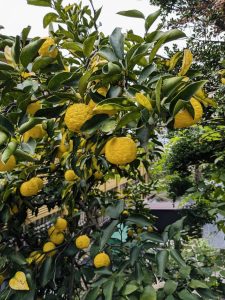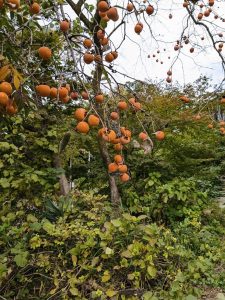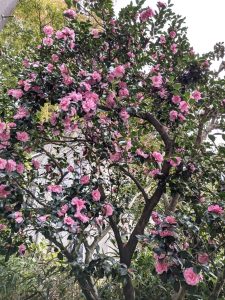秋の実りを満喫しております(愛知県名古屋市千種区姫池通 骨董買取 古美術風光舎)
2024.11.27
皆さまこんにちは。スタッフHでございます。
秋も深まり、木々には様々な果実が実っていて散歩も楽しくなります。本日も鮮やかな黄色に色づいた柚子に目がとまりました。

ビタミンCが豊富で様々な料理にも応用しやすいので、これからの時期は積極的に取り入れたい食材です。個人的には大根とゆずの浅漬けが好きですが、他にもゆずジャム、ゆず味噌、ゆずポン酢など一味違う調味料に変身し、寒い冬を乗り切るには欠かせません。
柚子の種だけを醤油につけておくだけでも、さっぱりとした柚子醤油になりお勧めです。
他に私の秋の楽しみといえば柿です。みなさまはシャキシャキした柿と熟した柿ではどちらがお好みでしょうか?

私は完全に熟した柿を冷たく冷やしてスプーンでいただくのが大好物なのですが、友人には結構引かれてしまいます。個人的にはこれ以上のデザートはないと思っているのですが…。
最近料理番組で目にした、柿とモッツアレラチーズと生ハムのサラダも美味しそうでした。絶対にお酒がすすむ味ですよね。只今お酒を控えておりますので、特別なイベントの時にぜひ試してみたい一品です。
食べ物の話ばかりしておりますが、お花もしっかりと目に入っておりますよ。ご近所のピンク色の山茶花(さざんか)が満開でした。花の少ない時期にこの艶やかな色は目立ちますね。

山茶花はツバキ科の常緑樹で、庭や道路沿いによく植えられていて、ピンクや白、赤などの鮮やかな花を咲かせます。椿と間違われることが多いようですね。
山茶花と椿では花の散り方に大きな違いがあり、椿は花が丸ごとポトッと落ちるのに対して山茶花は花びらが一枚一枚ハラハラと散ります。
しかし散るまでどちらか分からないのも考えものですので、他の区別の仕方として、花の咲く時期が山茶花の方が早く10月頃から咲きはじめ、椿は12月頃に咲きはじめるとか。
あとは花の形が椿は筒状で厚味があり立体的であるのに対し、山茶花は椿に比べ平面的で薄いとのこと。
最後はプロの領域に入りますが、葉の葉脈で見分けるのだそうです。椿は葉脈がクリアで山茶花は葉脈が黒っぽいのだそうですが、私は見分ける自信がありません。椿の葉の裏側はほとんど毛がなく、山茶花はうっすらと毛が生えているようですので、こちらの方が分かりやすいかもしれませんね。次回は葉の裏を観察してみようと思います。
さて、「さざんか」と聞くとつい口ずさんでしまうのが童謡の「たき火」の歌詞ではないでしょうか。♪さざんか さざんか さいたみち~♪とくちずさむだけで冬の情景が瞬時に目に思い浮かぶのですから、童謡の力はすごいです。
先ほどから「山茶花」という漢字を入力しながら、「さざんか」という音とのずれに妙な違和感を感じていました。
調べてみますと、さざんかは元々は「さんさか」や「さんざか」と呼ばれていたようで、それが変化して「さざんか」となったようです。「さんさか」では童謡も少し歌いにくい気がするのは私だけでしょうか。
収穫の多い秋の散歩、本格的な冬を前に楽しまれてはいかかでしょうか。
それでは、また次の機会に。
Hello everyone. This is Staff H.
Autumn is deepening and the trees are bearing a variety of fruits, making a walk enjoyable. Today, I was struck by the bright yellow color of yuzu citrons.
Rich in vitamin C and easy to apply to various dishes, yuzu is an ingredient that I would like to actively use from now on. Personally, I like to make asazuke (lightly pickled radish and yuzu), but it can also be transformed into yuzu jam, yuzu miso, yuzu ponzu, and other seasonings with a difference, and is indispensable for surviving the cold winter months.
I recommend just dipping the yuzu seeds in soy sauce to make a refreshing yuzu soy sauce.
Another autumn delicacy I look forward to is persimmons. Which do you prefer, crispy or ripe persimmons?
I love to eat a perfectly ripe persimmon cold with a spoon, but my friends are quite taken aback. Personally, I don’t think there is a better dessert….
Also, I recently saw a cooking show and the persimmon, mozzarella cheese, and prosciutto salad looked delicious. It definitely tastes good with alcohol, doesn’t it? I’m trying to cut back on alcohol right now, so this is definitely something I would like to try at a special event.
I know I’m talking about food all the time, but I also have my eye on flowers. The pink sasanquas in our neighborhood were in full bloom. This glossy color really stands out during a time of year when flowers are scarce.
The sasanqua is an evergreen tree of the camellia family, often planted in gardens and along roadsides, and produces bright pink, white, and red flowers. It is often mistaken for camellia.
There seems to be a big difference in the way the flowers fall between the yamacha and the camellia. In camellias, the entire flower falls off, whereas in sancha-hana, the petals fall one by one.
However, since it is difficult to tell which is which until the petals fall, another way to distinguish between the two is that the Yamacha flowers bloom earlier, starting around October, and the Camellia flowers start blooming around December.
The camellia’s flowers are cylindrical, thick, and three-dimensional, while the sancha-hana’s are flat and thin compared to the camellia.
Finally, entering the realm of professionals, they distinguish the leaves by their veins. Camellia leaves have clear veins, while santacha leaves have darker veins, but I am not confident that I can tell the difference. The underside of camellia leaves is almost hairless, while the underside of sancha-hana leaves seems to have a few hairs, so this may be easier to tell the difference. Next time, I will observe the underside of the leaves.
When you hear the word “sazanka,” you may be reminded of the lyrics of the children’s song “Takikibi” (“Bonfire”). The power of nursery rhymes is amazing, because just by humming the words “sazanka sazanka sazanka saitamichi~,” a scene of winter instantly comes to mind.
While typing in the kanji character for “sancha bana” earlier, I felt a strange discrepancy with the sound “sazanka”.
Upon further research, it seems that sazanka was originally called “sansaka” or “sanzaka,” which changed and became “sazanka. Am I the only one who feels that “sanzaka” makes nursery rhymes a little difficult to sing?
Why don’t you enjoy a walk in autumn, when the harvest is plentiful, before winter sets in?
See you next time.
*******************
ご実家の整理やお片付けなどをされている方のご相談などが多くございます。
お片付けなどくれぐれもご無理のないようになさってくださいませ。
風光舎では古美術品や骨董品の他にも絵画や宝石、趣味のお品など様々なジャンルのものを買受しております。
お片付けをされていて、こういうものでもいいのかしらと迷われているものでも、どうぞお気軽にご相談下さいませ。
また風光舎は、出張買取も強化しております。ご近所はもちろん、愛知県内、岐阜県、三重県その他の県へも出張いたします。
まずは、お電話お待ちしております。
愛知県名古屋市千種区姫池通
骨董 買取【古美術 風光舎 名古屋店】
TEL052(734)8444
10:00-18:00 OPEN
#出張買取#骨董#古美術#骨董品#絵画#版画#茶道具#刀剣#彫刻

